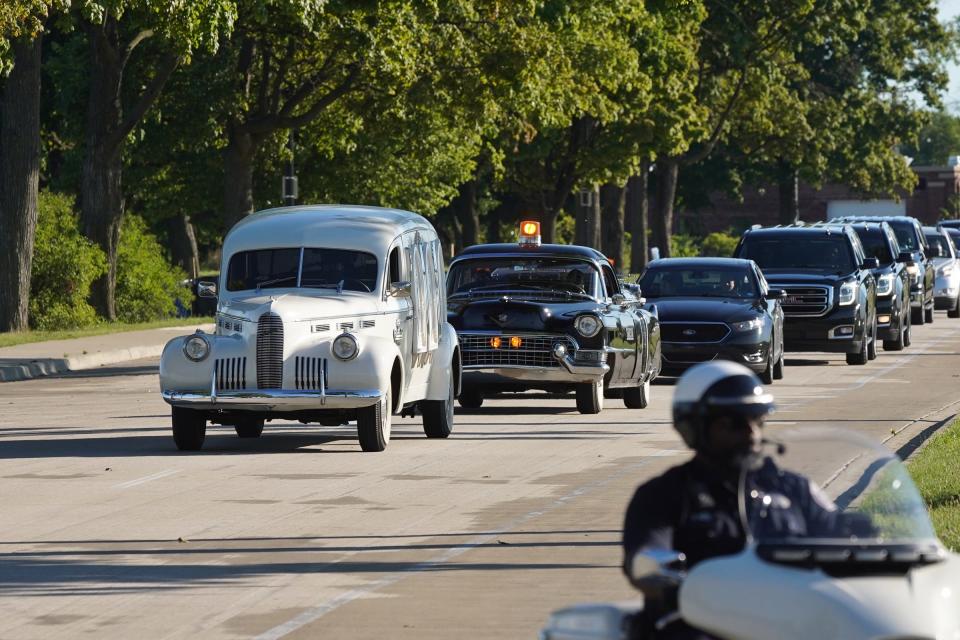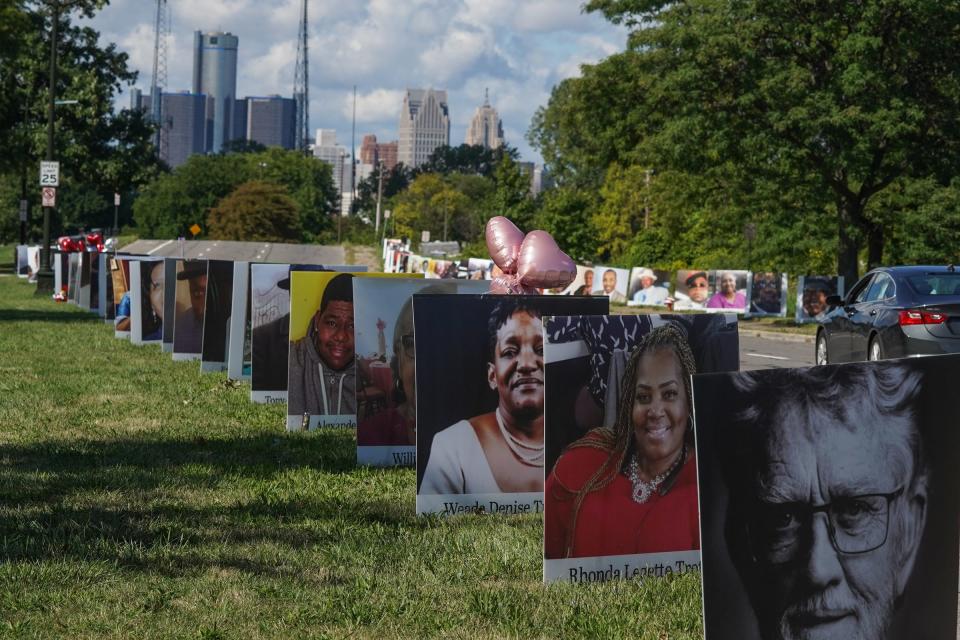For 1st time in Michigan history, more people died than were born in 2020
For the first time in Michigan's recorded history, deaths outpaced births in 2020 — a situation worsened by the wave of deaths from COVID-19, said Kurt Metzger, a demographer who founded Data Driven Detroit and studies Michigan population trends.
In the first year of the pandemic, 104,149 babies were born in Michigan but 117,087 people died in the state, Metzger said — a difference of 12,938.
"Looking at those numbers, I just said, 'Whoa! Here we are,' " said Metzger, who used data from the state health department to make the analysis. "It's the first time we've ever seen more deaths than births, which is kind of frightening."
Among them were 11,362 Michigan residents who died from COVID-19, according to the state health department's 2020 mortality data, which counts only people for whom COVID-19 was listed as the underlying cause of death.

More: Michigan coronavirus cases: Tracking the pandemic
More: COVID-19 hospitalizations beginning to ease, Detroit-based Henry Ford Health says
When added to a declining birth rate, an aging population and a lack of immigrants, Metzger said, COVID-19 exacerbated an already downward population spiral that could have wide-reaching economic and political implications for the state.
"It's not necessarily that growth is the answer to everything, but when you're not growing in population, people start to question decisions to move there or open businesses there or anything else," said Metzger, who also served for eight years as mayor of Pleasant Ridge.
"It is, overall, this aging population in Michigan and the inability to attract young, educated workers that has been a characteristic of the state for quite a while and doesn't seem to be changing at all."
Population losses also mean fewer federal dollars and other resources for the state, as well as less representation in Congress.
"We lost a congressional seat again," he said of redistricting, which this year dropped the number of U.S. House districts in Michigan to 13. "We've lost one every 10 years since 1970. ... If we continue to lose as we've had, Michigan's role just becomes diminished.
"Population and other characteristics are vital to funding formulas and we know that Michigan will, as it keeps losing population, keep losing federal funds," he said, noting, however, that COVID-19 federal relief has helped to buoy state coffers at least temporarily.

More: Michigan's redistricting commission adopts final congressional map for the next decade
More: Rep. Brenda Lawrence, Michigan's only Black member of Congress, not running again
"If we ever got back to a normal state of things, our funding would continue to go down."
The birth rate in Michigan has been on a downward trend since the 1950s. By 2019, the most recent year for which data was available, the birth rate had dropped to 10.8 per 1,000 people — the lowest point since 1950, when it was more than double that — 25.1 per 1,000 people.
Even though the U.S. overall also has a declining birth rate, Michigan's is lower than the national average of 11.4 per 1,000 population.
The pandemic has just piled on, Metzger said, because "people are delaying births even more because of COVID" even as more people are dying from the virus.
COVID-19 became the third-leading cause of death in Michigan in 2020, behind only heart disease and cancer.
"We can blame a lot of deaths on COVID," Metzger said, "but the fact is the trend of increasing deaths and decreasing births is a problem for Michigan outside of COVID."
Exactly how many people died in Michigan from the virus in 2020 differs depending on how a COVID-19 death is defined.
The state health department has published two charts that show three different death statistics from the virus in the first year of the pandemic.
The 2020 mortality rate table shows 11,362 people Michigan residents for whom coronavirus was the underlying cause of death, regardless of what state they were in when they died. That number has been finalized, said Chelsea Wuth, a spokesperson for the state Department of Health and Human Services.
"It includes only people whose underlying cause of death was COVID-19 per the death certificate," Wuth said. "It does not include people where COVID was a contributing factor, but wasn’t the underlying cause."
The state health department also published a chart detailing the number of COVID-19 deaths by age in 2020. It suggests there were 12,570 provisional COVID-19 deaths in Michigan that year.
That number may still be adjusted, Wuth said, and includes deaths from non-Michigan residents who died in the state as well as people for whom COVID-19 was listed as either the underlying or contributing cause of death.
"The underlying cause of death is defined as the disease or condition that sets in motion the chain of morbid events resulting in death," Wuth said. "For COVID-19-related deaths, the medical certifier might indicate that COVID caused the death, or that it was only a contributing condition."
That chart also includes 13,002 COVID-19 "fitted deaths" in 2020. That number, Wuth said, is a statistically scaled estimate with data reported in the Michigan Disease Surveillance System, which tracks lab-confirmed cases of the virus and also documents COVID-related mortality reported by local health departments.
"Because MDSS numbers are more timely than death certificate numbers, the statistical fitting allows us to track the relative agreement between the two systems," Wuth said.

Regardless of how COVID-19 deaths are counted, Metzger said the data clearly show that some counties fared better than others when it came to population changes in 2020.
The biggest population loss was seen in Macomb County, which shrunk by 2,045 residents in 2020.
Wayne and Genesee counties lost 1,269 and 1,220 people, respectively, followed by a 723-person loss in the city of Detroit.
Saginaw, Bay, St. Clair and Oakland counties also were among the state's biggest losers in 2020, with population reductions ranging from 609-714 people each.
While most Michigan counties saw falling population numbers, seven saw gains in 2020. They were:
Kent County, which grew by 2,465 people.
Ottawa County, which grew by 576 people.
Washtenaw County, which grew by 533 people.
Ingham County, which grew by 217 people.
Kalamazoo County, which grew by 211 people.
Ionia County, which grew by 26 people.
Branch County, which grew by 19 people.
That growth was concentrated, Metzger said, on the west side of the state.
"That area has been the fastest-growing for a long time. But it just shows because of migration into that area of a younger population you're seeing the higher numbers of births," he said. "And then it's also three counties that have universities — Washtenaw, Ingham and Kalamazoo" that also have seen modest growth.
"They're not large numbers, but because of the younger population, they continue to be able to to maintain that population."
The opposite is happening in metro Detroit.
"All of those older, central metro counties are showing significant losses," he said. "Oakland had 609 more deaths than births."
That's true for the state overall, too.
"I looked at the United Van Lines numbers, U-Haul numbers, and Michigan is toward the bottom in terms of move-ins and at the top of move-outs," Metzger said. "Everything is pointing to continued loss of population, and for me, that should be of some concern to the powers that be."
COVID-19, he said, will only intensify the problem in 2021, Metzger said.
"We know that more people died from COVID in 2021 than died in 2020," he said. "For a state that does not attract … migrants, combined with lower immigration numbers ... and then you get more deaths and births, you start to wonder, OK, what is the future in Michigan? How do you start to reverse those things?
"The number of deaths in Michigan are continuing to go up just because of our aging population. Birth rates, birth trends are indicating that those numbers will continue to go down.
"I think the answer is how does Michigan attract immigrants? How does Michigan attract young folks in their child-bearing ages to come to the state?
"It's just another indication that Michigan has a lot of work to do."
Contact Kristen Jordan Shamus: kshamus@freepress.com. Follow her on Twitter @kristenshamus.
This article originally appeared on Detroit Free Press: Michigan population: Deaths outpaced births for 1st time

